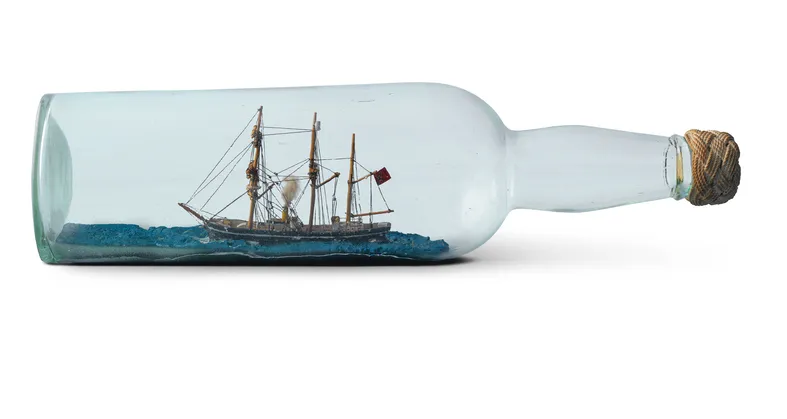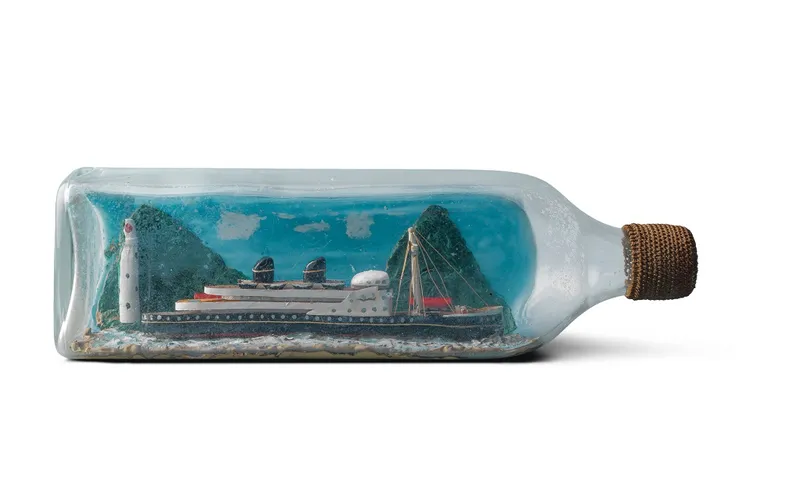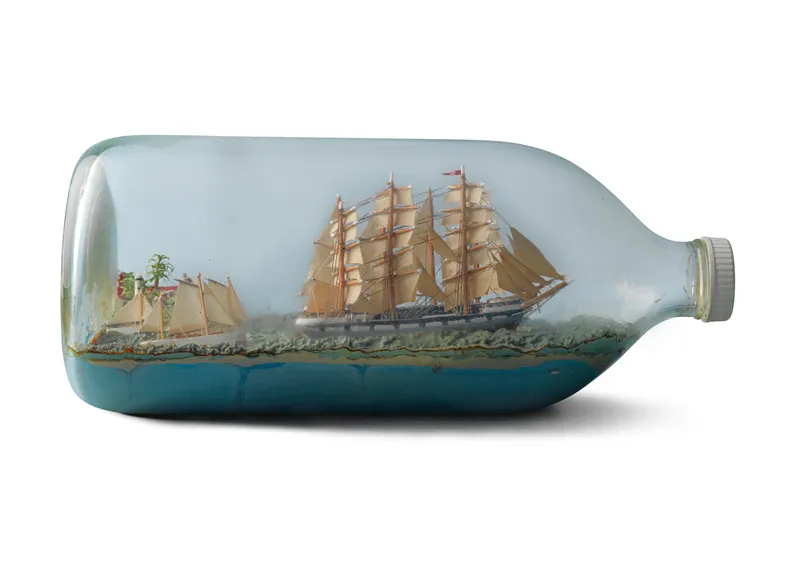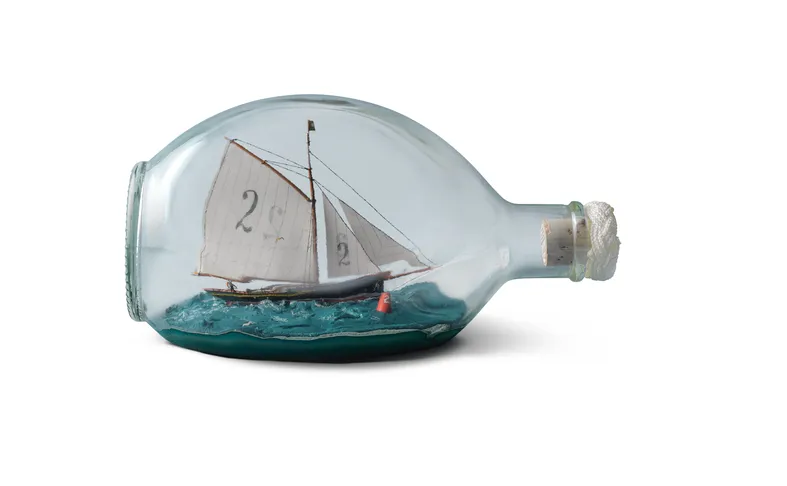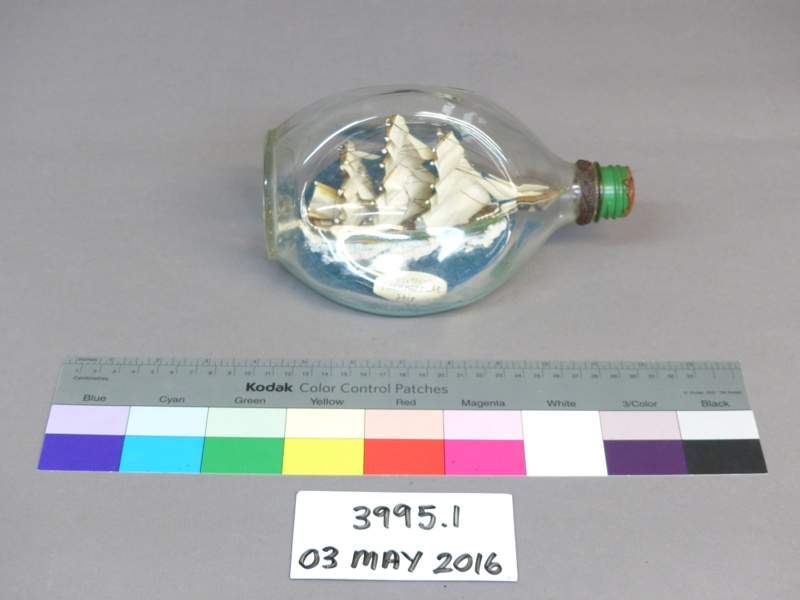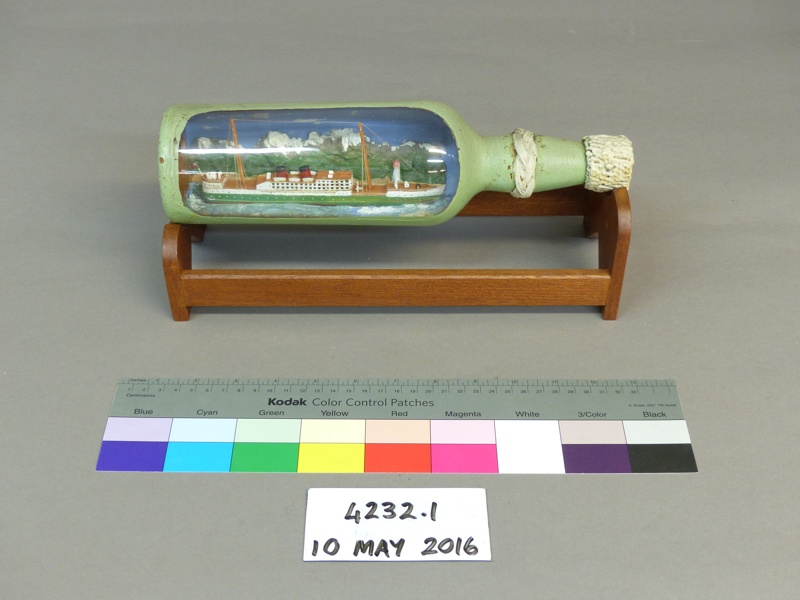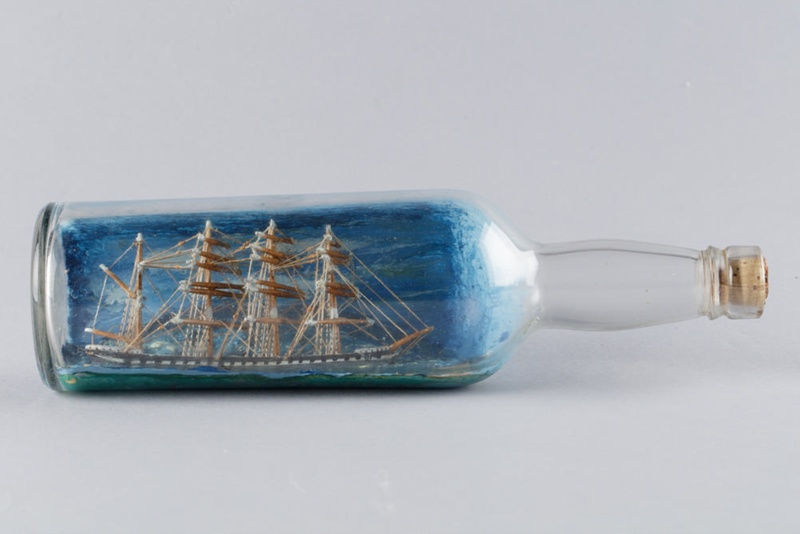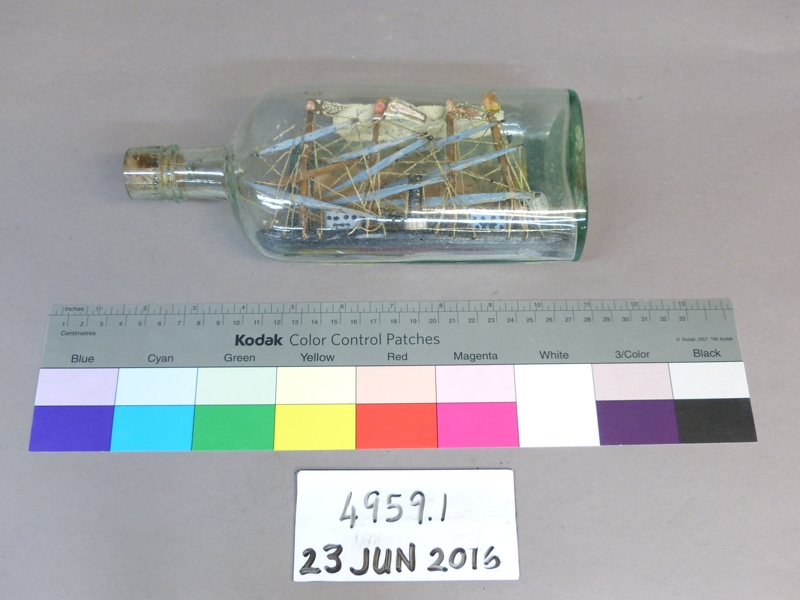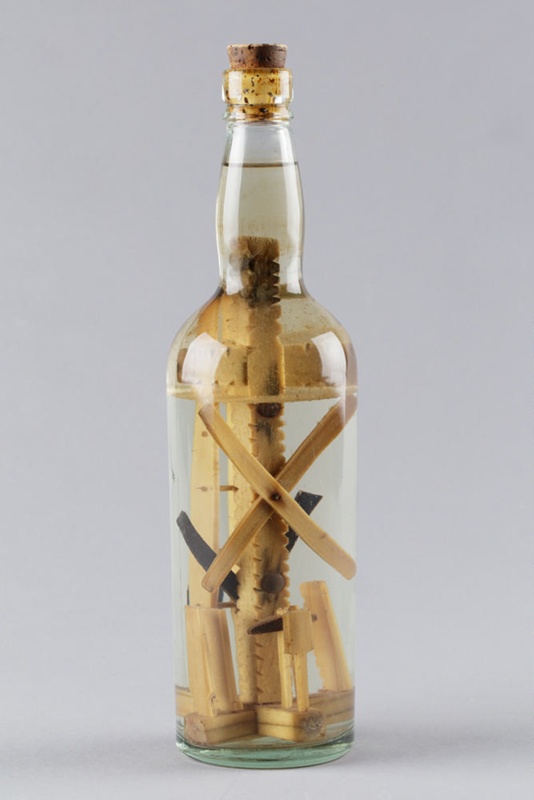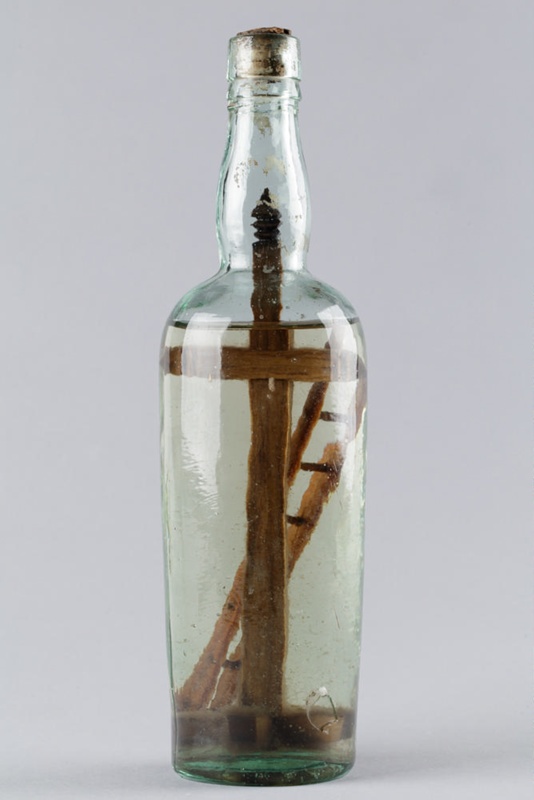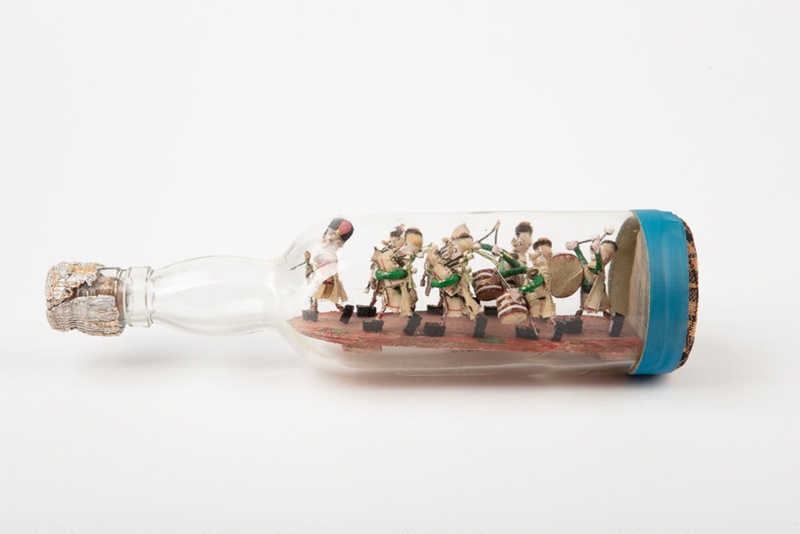Nicknamed SIBs, and made by those who are seriously detail-oriented, ships in bottles have been around since at least the mid-1800s. Frances Walsh, writer at the New Zealand Maritime Museum looks at their origins and appeal.
There’s something about a ship in a bottle. The logistics are baffling—the model ship is way too big to fit through the mouth. Then, there’s the attraction of the miniature, which reduces the large and complex to the small and examinable. Toylike SIBs are also freighted with nostalgia and longing—including for pre-industrial labouring and crafting.
The practice of wrangling objects into bottles originated in Europe. One of the earliest surviving examples features miners at their work, made by Matthias Buchinger in 1719. Buchinger was no less a marvel than his creation—born in Bavaria without hands or feet, he was a gifted magician, musician, and calligrapher.
By the nineteenth century, Irish Catholics were referencing the Passion in glass bottles, vertically suspending crosses, ladders, hammers, nails, spears, crowing cocks etc., in oil and white vinegar. Maybe the artefacts were talismanic. Mysteriously, the figure of Jesus is always absent. The genre is referred to as God-in-a-bottle, or GIBs, and is still kept alive by a few folk-artists in Ireland today.
SIBs appeared around the 1850s, when improvements in glass bottle production afforded a clearer, less distorted view of interiors. By 1900 bottles had also become less expensive as mass production began displacing hand-blown glass. Specialist bottles such as Johnny Walker’s square one—a shape designed to minimise breakages in transit—as well as the three-sided, dimpled Haig’s whisky bottle, were manufactured from 1860 and 1888 respectively, and were popular with bottlers because they had short necks and didn’t roll about.
Working and retired seafarers, lighthouse keepers, fishers, and various sedulous characters from all major sea-going nations produced SIBs. They carved the hull from wood and set the vessel in a putty sea-base up to the waterline. Reflecting developments in naval architecture and the passing of the age of sail, the types of vessels featured expanded—from steamers and passenger liners to hospital ships.
Some makers of SIBs were maximalists: among the works of ‘extraordinary genius’ on display at the New Zealand Centennial Exhibition in 1939 were SIBs by Mr R. J. Ricketts of Nelson, reported The Evening Post. One contained a four-masted barque, a three-masted barque, a yacht, a steamer, two tugs, a seaplane, and a lighthouse. Rickets took out first prize in the Exhibition’s model section for his variation on SIBs—a collection of light bulbs (1-10 inch long), into which he placed knee-high-to-a-grasshopper ships. By trade a shipwright, Ricketts commenced bottling in 1934 after seeing a SIB in a Hokitika pub and persuading the barkeep to give it him for study purposes.
SIB makers often added sweet flourishes. Ernie Harrison attached a plume of smoke made from wool onto his model of Ernest Shackleton’s 1912 barquentine Endurance [Fig. 1]. In 1899 the thirteen-year-old Harrison had joined Shaw Savill’s steamer Waiwera in London as a deck boy, and many hairy Cape-Horn roundings later retired to Levin. Wanting to make scale obvious, Des Newton planted a Lilliputian at the tiller of his 1846 Liverpool pilot cutter Teaser [Fig. 4], and a buoy in the choppy surrounding waters. A former submarine welder, Newton was the SIB demonstrator at Liverpool’s Merseyside Maritime Museum until 2005, describing himself as ‘a glass receptacle miniature artefact inserter’.
As to how Newton and co wrangled their model ships into bottles, James Bisset explains in Sail Ho! My Early Years at Sea. In 1901 Bisset was serving in County of Pembroke, two years into an ‘apprenticeship in sail’, and bound for England from Portland USA.
"One of our sailors throughout the voyage had been working in the dog watches at putting a ship into a bottle, a task it had taken him twelve months to complete. With endless patience he had built a ship in miniature from pieces of wood, whittled with his jackknife, and had rigged her correctly with all sails to the royals on her three masts, using thin tarred twine for rigging and carefully carved tiny pieces of wood for blocks and tackles. There was nothing omitted. She was complete with deckhouses, wheel, binnacle, capstans, anchors, bitts, even belaying pins in the rails. She was painted and varnished and perfect. When we arrived at Portland, the old seaman obtained a narrow-necked bottle, and some putty and green colouring matter for the ‘sea’. After rubbing the colour into the putty, he ran it into the bottle lying on its side. Then came the great moment of putting the ship into the bottle. He cut the masts off short at the deck and hinged them, so that the whole top hamper lay down flat in a fore-and-aft direction. Then he inserted the ship, stern first, through the neck of the bottle, and manoeuvred her on the sea of green putty into a central position. When she was firmly settled there, he gently pulled on fine threads attached to the masts and the yards and passing through the end of the jib boom and out through the neck of the bottle. With these threads he raised the masts to a vertical position and trimmed the yards horizontally. Hey presto! A ship in a bottle!"
Bisset bought the wonder for two pounds of chewing tobacco, to give to his mother to put on her mantelpiece. ‘A real work of art, I considered it,’ he writes.
References:
Bisset, James. Sail Ho! My Early Years at Sea. Sydney: Angus and Robertson, 1958.
“Builder of Model Ships Dead”, The Press, February 12, 1958, 8.
“Display of Models.” The Evening Post, November 14, 1939, 11.
Grennan, Geraldine. “Keeping the ‘God in the Bottle’ craft tradition alive.” Offaly Independent, Feb 3, 2023.
Hoare, Philip. “Gods in bottles and concrete crocodiles: British Folk Art at Tate Britain.” The New Statesman, July 3, 2014.
Lucretius. De rerum natura. Translated by Frank O. Copley [The Nature of Things]. New York: W.W. Norton & Company, 1977.
Stammers, Michael. “Ships in Bottles and Their Origins in the Late Nineteenth Century.” The Mariner's Mirror 99, no. 1 (2013): 92-94.
Stewart, Susan. On Longing: Narratives of the Miniature, the Gigantic, the Souvenir, the Collection. Durham & London: Duke University Press, 1993.
“Tributes to expert ship bottler.” BBC Liverpool, February 5, 2009.
